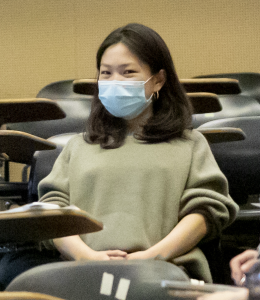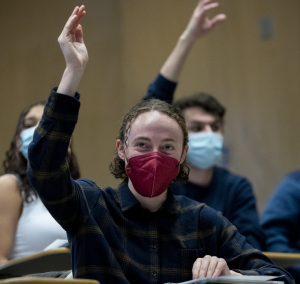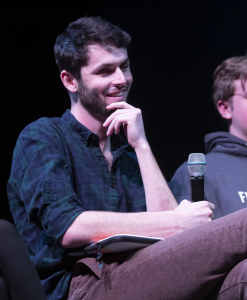By Amanda Metzger (BFF 2022, Bates Class of 2022)
When we began creating this film festival, I had many expectations for what it would look like and what our tasks would be. Reading the syllabus at first felt overwhelming! Not only were there several pages worth of mini assignments, but we were also expected to watch all these films, reach out to filmmakers, and participate in the actual festival. This seemed like a daunting task, but as the semester progressed, each of these assignments felt manageable. I was surprised by how easy it was for me to email a professor I had never spoken to and ask them for money or ask a filmmaker for permission to use their film. It was not as high pressure as I’d imagined, and at the end of the semester, I felt that I had learned a lot not just about how much goes into planning a film festival but also how labor intensive and exciting it can be.
“I was surprised by how easy it was for me to email a professor I had never spoken to and ask them for money or ask a filmmaker for permission to use their film.”

One of the assigned readings that I found particularly relevant was Marijke de Valck’s “What is a Film Festival.” In it, de Valck explains some of the major criteria used to categorize festivals, and many of these were fundamental to our own “festival building” process. Granted, some of the factors that de Valck’s mentions (like the target audience and the scale of the festival) had already been determined based on the fact that this is a film festival held (partially) at a college and in a small town in Maine. However, students in the class had a big influence on the tone of the festival. We already knew that we were trying to draw in the general Bates audience and an audience in Freeport, but it was our job to balance films that we thought were really important to show with those films that we thought would bring in an audience.
Being part of the festival’s documentary team carried this challenge. All of the documentaries that we watched were important in their own way. However, as a team, we had to balance our selections. Some in our audience might not want to watch films about horrific war crimes, environmental collapse, sexual violence, and depressed high school students. I worried about how this would affect their desire and willingness to return for a second BFF event. Street Gang became my favorite film. It was really the only documentary we watched that didn’t feel incredibly heavy. It mixed really serious topics with humor and childhood nostalgia. For me, it had to be included in the festival lineup!

The film options from which we chose set a clear tone for the festival. At Bates, we are encouraged to always choose the path with the most discussion and to highlight important issues wherever possible. It was interesting, then, to also have to keep in mind the marketing of the festival. This was one of the first classes I had that wasn’t just about broadening our knowledge of film and society. It was also about considering which films would excite (and not overly depress) our audiences. Had this simply been a film class, I think the films we selected would have been different. Since we were putting on an event where the size of the audience could potentially make individual screenings/discussions more valuable, we had to balance a diversity of topics with audience appeal.
I felt de Valck’s notion of “identity based film festivals” also applied to the BFF (3). De Valck suggests that these festivals target specific audiences. As examples, she lists Jewish film festivals, LGBT film festivals, and Asian American film festivals. Our film festival is unique in that we target a specific demographic (other Bates students and faculty) and also audiences that reside in local communities like Lewiston/Auburn and Freeport. When it came to the Freeport audience, I expected it to be a fairly homogeneous group demographically, reflecting the Maine population in general. However, the selections the class made received a very different response from the Freeport audience than what we anticipated. Some of the films that we were unsure of were very popular in Freeport. Conversely, some of the titles we were most keen to show received an uneven response. In some ways, this was a good thing since the audiences still liked our selections (whether they were short films, narratives, or documentary features). However, the wide disparity between our scores and those of our Freeport audience on some titles carried with it important lessons about the assumptions we make about audiences and our own viewing preferences.
“As I reflect on the festival, I am really impressed with our audiences at Bates and in Freeport. They asked really intelligent and relevant questions, and they did not seem to commit any of the Q&A sins.”
At the festival, I moderated the Q&A with Trevor Crafts, Ellen Scherer Crafts, and Marilyn Agrelo following the Friday night screening of Street Gang. I found this very intimidating. In “Q&A 101: Everything You Should Never Ask Talent After Watching a Movie,” Eric Kohn, Jude Dry, et. al. present a clear and brisk analysis of questions that are inappropriate to ask during a Q&A. These range from “multi-part question[s]” to not trying “to get advice about your own career.” This article is aimed towards a general audience rather than someone who is directly interviewing the talent. However, as I reflect on the festival, I am really impressed with our audiences at Bates and in Freeport. They asked really intelligent and relevant questions, and they did not seem to commit any of the Q&A “sins.” When I ran the Q&A for Street Gang, I drew on the Kohn, Dry, et. al. reading, and I hope that the result was both helpful to audience members and respectful to the filmmakers.
I also learned that while these guidelines are helpful, the structure of a Q&A and what’s appropriate to ask varies greatly based on the person you are interviewing. My Q&A for Street Gang felt like an appropriate time to adhere strictly to these guidelines. However, at the Q&A with John Shea, a Bates graduate returning to his alma mater, it would have been appropriate to ask questions that this article discourages like “What advice would you give to other actors?” and “Can you further explain this specific plot point?” Overall, while reading about the theory behind film festivals was helpful, I found that the actual experience of organizing and running the Bates Film Festival inevitably deviated from the textbook understanding of what a film festival is or should be. This was an incredible experience and a great way to dip my toe into the film festival world while still having the structure and support of a classroom setting.
Works Cited
de Valck, Marijke. “Introduction: What is a Film Festival? How to Study Festivals and Why You Should.” In Film Festivals: History, Theory, Method, Practice. Marijke de Valck, Brendan Kredell, and Skadi Loist, eds. 1-11. New York: Routledge, 2016.
Kohn, Eric, Jude Dry, Kate Erbland, David Ehrlich, Chris O’Falt, and Michael Nordine. “Q&A 101: Everything You Should Never Ask Talent After Watching a Movie.” Indiewire, 26 Apr. 2018, https://www.indiewire.com/2018/04/qa-etiquette-guidelines-movie-screening-1201956447/. Accessed 11 Jun. 2019.






